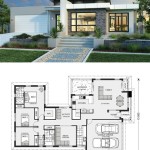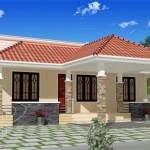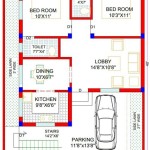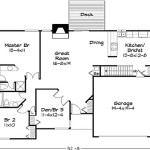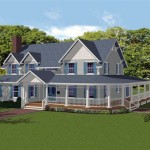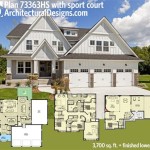```html
Post and Beam Home Plans: A Comprehensive Guide
Post and beam construction represents a distinctive approach to home building, characterized by its use of heavy timber framing. This method differs significantly from conventional stick-built construction, where walls bear the primary load. In post and beam structures, the load is transferred to a framework of substantial vertical posts and horizontal beams, resulting in an open and spacious interior.
The resurgence of interest in post and beam construction stems from several factors, including its aesthetic appeal, structural integrity, and potential for energy efficiency. Understanding the nuances of post and beam home plans is crucial for anyone considering this building style. This article will delve into various aspects of these plans, covering their benefits, design considerations, and resource exploration.
Understanding the Fundamentals of Post and Beam Design
The cornerstone of post and beam construction lies in its structural system. Instead of relying on numerous smaller studs and joists, it utilizes widely spaced, large timbers for both vertical and horizontal support. These timbers, typically spaced 8 to 16 feet apart, create large, open spaces between the posts and beams. These spaces can then be infilled with various materials, such as conventional framing, insulated panels (SIPs), or even glass, allowing for design flexibility.
Several key elements define post and beam design:
- Posts: These vertical members are the primary weight-bearing components, transferring the load from the beams down to the foundation.
- Beams: These horizontal members span the distance between the posts, supporting the roof and floor loads.
- Joinery: The method used to connect posts and beams is critical to the structural integrity of the building. Traditional joinery techniques, such as mortise and tenon joints, are commonly employed, often secured with wooden pegs. Modern methods may involve metal connectors for increased strength and ease of construction.
- Infill: The spaces between the posts and beams are filled with materials to create walls and provide insulation. The choice of infill material significantly impacts the building's energy efficiency and aesthetic.
Post and beam plans are typically more complex than those for conventional stick-built homes. Structural engineers play a vital role in ensuring the design's stability and compliance with local building codes. Detailed drawings, including beam spans, post sizes, and joinery details, are essential for a successful project.
One of the advantages of post and beam is the ability to create dramatic, open living spaces. The absence of load-bearing interior walls allows for flexible floor plans and expansive views. This makes post and beam homes particularly appealing to those who appreciate a modern, airy aesthetic.
Key Considerations When Choosing Post and Beam Home Plans
Selecting a post and beam home plan requires careful consideration of several factors. These considerations encompass practical aspects, aesthetic preferences, and budgetary constraints.
1. Structural Integrity and Engineering: The structural integrity of a post and beam home is paramount. The plan must be engineered to withstand local wind and snow loads, as well as seismic activity. Engaging a structural engineer with experience in post and beam construction is crucial. The engineer will review the plans, ensure they meet building codes, and provide necessary calculations and specifications.
2. Material Selection: The choice of timber species significantly impacts the home's appearance, durability, and cost. Common timber species for post and beam construction include Douglas fir, oak, and pine. Each species has unique characteristics in terms of strength, grain pattern, and resistance to decay. The selection process should consider the local climate and the desired aesthetic. Furthermore, the source of the timber should be carefully considered, favoring sustainably harvested wood whenever possible.
3. Energy Efficiency: While post and beam homes can be energy efficient, careful attention must be paid to insulation and air sealing. The infill material between the posts and beams plays a critical role in thermal performance. Structurally insulated panels (SIPs) are a popular choice due to their high R-value and ease of installation. However, other options, such as conventional framing with spray foam insulation, can also be effective. Proper air sealing is essential to prevent drafts and minimize energy loss. The design should incorporate strategies for passive solar heating and cooling to further reduce energy consumption.
4. Aesthetic Preferences: Post and beam construction offers a wide range of aesthetic possibilities. The exposed timber frame can be left natural or stained to complement the interior design. The choice of infill material also impacts the overall look of the home. Glass walls can create a modern, light-filled space, while wood siding can provide a more traditional aesthetic. The design should reflect the homeowner's personal style and preferences. Considerations should also be given to the exterior design, including the roofline, window placement, and landscaping.
5. Budget Considerations: Post and beam construction can be more expensive than conventional stick-built construction, particularly when considering the cost of the timber frame and specialized labor. However, the long-term benefits, such as increased durability and potential for energy savings, can offset the initial costs. It is essential to develop a realistic budget that accounts for all aspects of the project, including design fees, materials, labor, and permits. Obtaining multiple bids from experienced contractors can help ensure competitive pricing.
Resources for Finding and Evaluating Post and Beam Home Plans
Numerous resources are available for individuals seeking post and beam home plans. These resources range from online plan providers to specialized design firms and construction companies.
1. Online Plan Providers: Several websites offer pre-designed post and beam home plans. These plans can provide a starting point for a project and can be customized to meet specific needs. However, it is crucial to carefully review the plans to ensure they meet local building codes and structural requirements. It is also advisable to consult with a structural engineer to verify the plan's integrity.
2. Architectural Design Firms: Hiring an architect with experience in post and beam construction is often the best approach. An architect can create a custom design that reflects the homeowner's unique needs and preferences. They can also oversee the project from conception to completion, ensuring that the design is properly executed. When selecting an architect, it is essential to review their portfolio and ask for references from previous clients.
3. Post and Beam Construction Companies: Some companies specialize in the design and construction of post and beam homes. These companies typically offer a complete package, including design, engineering, fabrication, and construction. This can be a convenient option for those who prefer a turnkey solution. When choosing a construction company, it is crucial to verify their experience, qualifications, and reputation. It is also advisable to obtain multiple bids and compare their services and pricing.
4. Timber Frame Associations: Organizations like the Timber Framers Guild provide valuable resources and information about timber frame construction. They offer directories of qualified timber framers and designers, as well as educational materials and workshops. These associations can be a valuable resource for anyone seeking to learn more about post and beam construction.
5. Local Building Codes and Regulations: Before embarking on a post and beam project, it is essential to familiarize oneself with local building codes and regulations. These codes govern various aspects of construction, including structural requirements, energy efficiency standards, and fire safety regulations. Consulting with local building officials can help ensure that the project complies with all applicable codes. This proactive approach can prevent costly delays and ensure a successful outcome.
By carefully considering these factors and utilizing available resources, individuals can make informed decisions when selecting post and beam home plans and embarking on this unique and rewarding building style. The blend of structural strength, aesthetic appeal, and design flexibility inherent in post and beam construction continues to make it a compelling choice for discerning homeowners.
```
Residential Floor Plans American Post Beam Homes Modern Solutions To Traditional Living

Post And Beam Homes 10

Log Timberframe Post And Beam Homes Oakbridge Timber Framing

Post And Beam Floor Plans That Work

Residential Floor Plans American Post Beam Homes Modern Solutions To Traditional Living

Timber Frame Home Plans Brooks Post Beam

Timber Frame House Plan Design With Photos

Most Requested Timber Frame Floor Plans Check Them Out

Small Post And Beam Floor Plan Eastman House Barn Interior Yankee Homes Home

House Plans The Valleyview Cedar Homes

